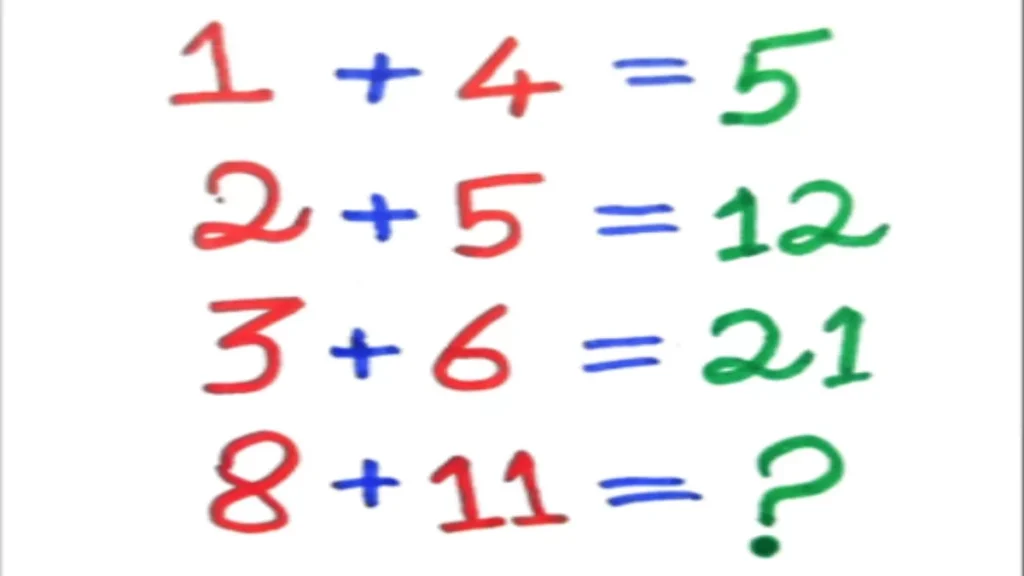A puzzle that intrigues internet users
A puzzle shared on social media has recently captured the interest of users due to its unusual mathematical patterns. Puzzles have long been a favored pastime for challenge enthusiasts, blending enjoyment, logic, and reflection. Whether it’s a complex riddle or a deceptive math problem, they spark curiosity and put the mind to the test.
Mathematical puzzles, in particular, hold a special place in this trend.
Although they may seem simple at first glance, solving them often requires patience and mental agility.
If you enjoy exercising your brain with logical riddles, a new challenge circulating online might just leave you puzzled.
The puzzle that confounds the internet
A puzzle recently shared on social media has captivated the public’s attention for good reason.
Here’s the challenge:
1 + 4 = 5
2 + 5 = 12
3 + 6 = 21
8 + 11 = ?
At first glance, these equations seem illogical. Yet, it’s precisely this type of riddle that encourages thinking outside the box, disregarding traditional arithmetic rules to uncover hidden logic.
While some have quickly found the solution, others are still struggling to understand the reasoning.
Another equally perplexing challenge
Another puzzle, shared previously, also caused confusion online:
Once again, don’t expect to apply conventional mathematical rules. These riddles require identification of a scheme or clever twist, sometimes even confounding.
Ready to take on the challenge? Dive in, but keep in mind that these puzzles can take longer to solve than one might expect.
Why the internet loves these riddles
But what makes these puzzles so popular? The answer is simple: they immediately capture attention, stimulate the intellect, and provide a feeling of satisfaction once solved.
In a world where content is scrolled through quickly, these riddles offer a short, engaging, and stimulating format for the mind.
Additionally, they spark discussions, debates, and collective curiosity, making them particularly appealing on social media.
In short, they are a perfect blend of personal challenge and shared enjoyment.
Here are the solutions we found
Puzzle 1:
1 + 4 = 5
2 + 5 = 12
3 + 6 = 21
8 + 11 = ?
Step-by-step solution:
This puzzle follows a hidden logic, where each line uses the previous result to build the next one. Here’s the reasoning:
1 + 4 = 5
→ 1 + (4 × 1) = 5
2 + 5 = 12
→ 2 + (5 × 2) = 2 + 10 = 12
3 + 6 = 21
→ 3 + (6 × 3) = 3 + 18 = 21
8 + 11 = ?
→ 8 + (11 × 8) = 8 + 88 = 96
Possible answer: 96
Puzzle 2:
21 + 10 = 31
22 + 20 = 64
23 + 30 = 99
25 + 50 = ?
🔍 Step-by-step solution:
Here, the logic is not a simple addition.
We notice a growing structure, and with careful observation, an original mathematical rule is found:
21 + 10 = 31
→ 21 + (10 × 1) = 21 + 10 = 31
22 + 20 = 64
→ 22 + (20 × 2) = 22 + 40 = 62
(But here we get 62… so let’s try a different approach)
→ In reality, the logic seems to be:
(First number × second digit of the second number) + second number
Let’s see:
21 + 10
→ (21 × 1) + 10 = 21 + 10 = 31
22 + 20
→ (22 × 2) + 20 = 44 + 20 = 64
23 + 30
→ (23 × 3) + 30 = 69 + 30 = 99
25 + 50
→ (25 × 5) + 50 = 125 + 50 = 175
Possible answer: 175
And don’t forget, if you don’t want to continue having fun with tests and challenges, definitely don’t click here.

